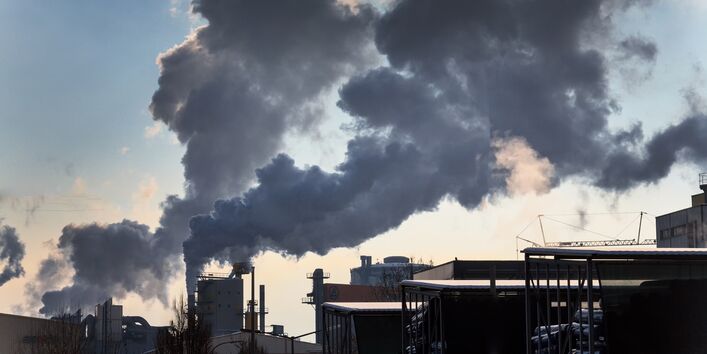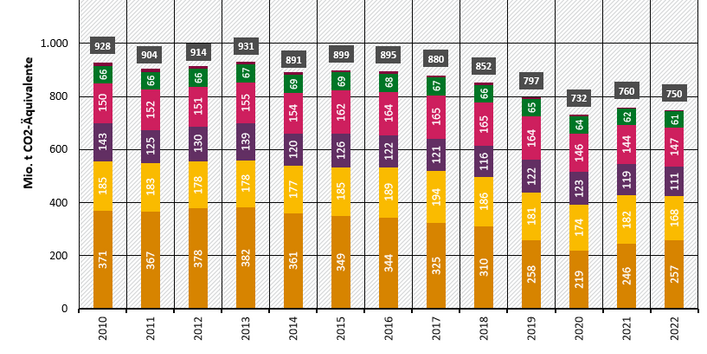Detailed greenhouse gas emissions figures for 2022: Emissions fell by 40 per cent compared to 1990 – EU climate protection targets met
Germany maintains its level of greenhouse gas reduction. The European emission reduction targets are fully met. This is revealed by the detailed data on greenhouse gas emissions for 2022. According to the data, a total of around 750 million tonnes of CO₂ equivalent was emitted in Germany in 2022. This is 9.6 million tonnes or 1.3 per cent less than in 2021 and 40 per cent less than in 1990. This is shown by the results of the calculations submitted to the European Commission by the German Environment Agency (UBA). In the sectors defined in the Climate Protection Act, the increase in the energy sector is particularly striking, while emissions have fallen in the industry and building sectors. With around 395 million tonnes of CO₂ equivalent in the non-emissions trading sector (primarily transport and buildings), Germany was once again able to meet its target under the European Union's Effort Sharing Regulation (ESR) in 2022.
Not least as a result of the energy crisis, greenhouse gas emissions in the energy sector rose by 11 million tonnes of CO₂equivalent or 4.5 percent in 2022. This was due to the increased use of coal. Emissions from the energy sector are therefore roughly as high as the sector target for the energy industry set out in the Climate Protection Act.
Emissions from industry fell in 2022: by 7.6 percent or 13.7 million tonnes of CO₂ equivalent. This is primarily due to the sharp rise in energy prices in 2022 as a result of the Russian war of aggression against Ukraine and the associated decline in production in various energy-intensive sectors. Emissions are below the sector target for industry under the Climate Protection Act.
Emissions from transport rose by 2 per cent in 2022 compared to 2021 to over 147 million tonnes of CO₂ equivalent. This increase is mainly due to road transport. While emissions from heavy goods vehicles and buses fell by almost 2 million tonnes of CO₂ equivalent, they rose by around 4.5 million tonnes of CO₂ equivalent for cars and light commercial vehicles. Following the drastic declines caused by the pandemic, emissions from domestic air traffic also recorded a significant percentage increase, which, in terms of absolute figures, contributed 0.3 million tonnes of CO₂ equivalent to the overall picture. The sector target of the Climate Protection Act for transport continues to be exceeded.
In contrast, emissions in the buildings sector fell by 8.8 million tonnes of CO₂ equivalent or 7.4 percent. This is mainly due to savings resulting from high gas prices in 2022 as a result of the Russian war of aggression against Ukraine and the population's efforts to save heating energy. For example, emissions from private households fell by around 7 million tonnes of CO₂ equivalent Nevertheless, the sector target of the Climate Protection Act for the building sector was exceeded.
A more detailed analysis of selected short and long-term drivers of combustion-related emissions can be found here: https://www.umweltbundesamt.de/node/73742
Greenhouse gas emissions from agriculture also fell slightly by around 1.0 million tonnes to 61.4 million tonnes of CO₂ equivalent This is primarily due to the continued decline in livestock numbers. Emissions from agriculture are therefore below the sector target of the Climate Protection Act.
Emissions per greenhouse gas
At 89.5 per cent, carbon dioxide (CO₂) continues to dominate greenhouse gas emissions in 2021 – largely from the combustion of fossil fuels. The remaining emissions are divided between methane (CH₄) at 6.1 per cent and nitrous oxide (N₂O) at just under 3.1 per cent, predominantly from the agricultural sector. Compared to 1990, emissions of carbon dioxide fell by 36.3 per cent, methane by 65.9 per cent and nitrous oxide by 54.0 per cent.
Fluorinated greenhouse gases (F-gases) account for only around 1.3 per cent of greenhouse gas emissions, but some of them have a very high global warming potential. Since 1995, fluorinated greenhouse gas emissions have fallen by 38.0 per cent, and there has been a clear downward trend since 2017 in particular.
Important note:
The categories listed in this text correspond to the classification system of the Climate Protection Act. The tables submitted to the EU, on the other hand, follow the classification system of the international reporting requirements. The total emissions are identical.
Further information:
The changes of minus 5.6 million tonnes of CO₂ equivalent compared to the published emissions data for 2022 in accordance with the Climate Change Act (see press release 11/2023 of 15 March 2023) are due to updates to the statistical information, which was only provisional at the time.
The official estimate for emissions in 2023 will be presented by the German Environment Agency in mid-March 2024 in accordance with the Climate Protection Act.

